The operations and maintenance manager at a 15 mgd regional drinking water plant in Huntsville, TX, a long-term user of chlorine dioxide for taste and odor control, reports that installation of a new chlorine dioxide generator has eliminated fouling-related maintenance downtime, while providing for further reliability improvement on account of its more "user-friendly" configuration.
The new Sabre Chlorine Dioxide Generator was designed and manufactured by Sabre Oxidation Technologies of Odessa, TX. Separate rotometers are used for sodium chlorite and chlorine gas, which are educted under vacuum through a mix chamber, where chlorine dioxide is formed.
"With the generators previously being included in the competitive bidding process, we had used virtually every chlorine dioxide generator since we started with that treatment program around 1986," said Keith Bass, Operations & Maintenance Chief for Southern Region Support Services, Trinity River Authority of Texas. "Now we've settled on this generator, with the bidding process limited to the chemicals."
"This new design has eliminated fouling in the throat and nozzle of the vessel where the chemicals are mixed. With previous generators we used, this fouling was happening every three to five days, causing downtime of a half hour to an hour for cleaning that sometimes required disassembling."
"It's also the most user-friendly unit we've had. You could teach a five-year-old how to use it in a matter of minutes. The other configurations were much more complex."
The 23-year-old plant sends all of its 15 mgd output to the City of Huntsville, its only customer. About 8 mgd is distributed for drinking water, including a seven mile pipeline for two prison farms, and the balance sent through a 30 mile pipeline to a power plant for cooling water.
Chlorine dioxide treatment was originally installed, upstream of clarification and filtration, to combat a serious algae problem on the clarifier basin, which derived from elimination of free chlorine that was needed to comply with trihalomethane(THM) limits per EPA's Safe Drinking Water Act.
Original dose of 5 ppm "helped a lot" with taste and odor problems related to the algal growth. When new rules mandated less than 1 ppm chlorite, chlorine dioxide feed was reduced to 2 ppm, and was still very effective. Current usage is said to still be driven by those "aesthetic" problems.
"This biogrowth maintenance is needed to prevent the clarifier basins from being overrun, which would decrease filtration efficiency, and increase the need for backwashing," Bass said. "While that probably wouldn't threaten our compliance, it certainly wouldn't be good for visitors to see."
Sabre generators are deployed at the raw water intake at the river, and also 300 yards from the plant, which is 4.5 miles from the river. Each is capable of delivering 300 lb/day of chlorine dioxide, at a maximum rate of 2.5 ppm, and probably averaging about 1.5 ppm annually. Only the generator near the plant is needed for most of the year. Daily production per generator ranges from 75-300 lbs, and averages about 125 lbs. A third generator is deployed at the Authority's 3 mgd Livingston Plant, at the intake from Lake Livingston.
The Sabre Chlorine Dioxide Generator features an "Integral Component Block Mounted (Solid State)" design that eliminates the need for extensive external tubes and valves and associated spare parts, promoting greater efficiency, improved performance, and minimized maintenance.
Its patented Tuned Reaction Column™ is said to eliminate clogging and insure a steady stream of precursor chemicals - allowing the unit to operate efficiently at lower water flows without variation in meter reading and with a greater turndown ratio, and without need for frequent flushing, disassembly, or cleaning.
Chlorine dioxide is generated at a minimum of 95% efficiency, with no more than 5% excess chlorine. Typical systems produce 10 to 1000 lbs/day. Systems with capacities up to 100,000 lbs./day are available.
Sabre Oxidation Technologies was started in 1995, with key experts who have now worked together on applications of chlorine dioxide and other oxidants for over 15 years. It is currently operating in the energy and environmental technology markets as well as in water treatment applications.
For further information, visit the company's website at www.sabretechnologies.com.




